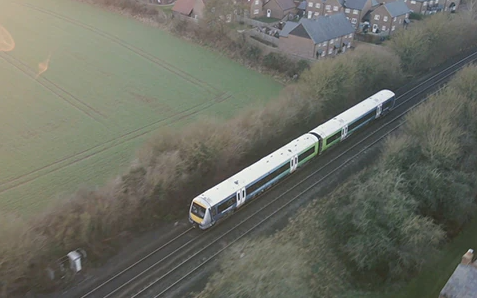Rolls-Royce Power Systems, Porterbrook work together to develop hydrogen in rail for U.K.
Multiple developments are aimed to support government goal to remove diesel-only trains by 2040 and achieve net-zero rail by 2050.

Photo Credit: Rolls-Royce, Porterbrook
(London, U.K.) have signed a memorandum of understanding (MOU) with U.K. rail rolling stock owner and asset manager (Derby, England), to identify and develop technological innovations to reduce carbon emissions and improve air quality across the rail network. The two companies will investigate the potential for the use of synthetic and net-zero fuels, including hydrogen, both in fuel cells and internal combustion engines, of which it can be assumed composite materials will most likely play a role (see “Hydrogen is poised to fuel composites growth, Part 1” and Part 2). Building on recent success of jointly introducing hybrid battery-diesel railcars into passenger service, Rolls-Royce and Porterbrook will also explore the potential for advanced hybridization.
The role of the wider rail ecosystem in decarbonization, including fuel chain supply, infrastructure and operational models that can aid innovation and the transition to net zero will also be considered.
“We have extensive experience of rail technology and are able to draw upon expertise from across our business in new net-zero and zero emissions technologies for safety-critical applications,” Warren East, CEO, Rolls-Royce says. “We are committed to helping our customers make the transition to net zero by enabling them to use our current and future products in a way that is compatible with emissions reduction, and this relationship with Porterbrook will help us further understand the options for decarbonizing rail transport. For us, playing a leading role in enabling the energy transition is both a societal imperative and a significant commercial opportunity.”
U.K. railway accounts for approximately 1% of all domestic greenhouse gas (GHG) emissions (according to 2019 figures. UK Department for Transport: Decarbonising Transport, 2021) and the Government’s ambition is to remove all diesel-only trains — both passenger and freight — from the network by 2040 and achieve a net-zero rail network by 2050. The UK Government has identified a number of different routes to this target, including alternative forms of power such as hydrogen, fuel cells, batteries, hybrid-electric and sustainable fuels.
“We have been at the forefront of developing alternative traction systems for rolling stock over recent years, through our innovations and long-term asset management approach. Our partnership with Rolls-Royce will mean that we continue to lead the U.K.’s rail sector in sustainable solutions, by leveraging expertise across industries on the pathway to net zero,” adds Porterbrook CEO Mary Grant.
has been active in this field, having already developed the hybrid-electric mtu Hybrid PowerPack, which recently entered commercial service in the U.K. with Chiltern Railways (U.K.) on HybridFLEX trains. Supplier by Porterbrook, the technology is said to reduce CO2 emissions by up to 25%.
Power Systems is currently developing a range of engines that can run on hydrogen, and fuel cells to be used as reliable power supply in ships and heavy-duty, off-highway vehicles. In 2021, Power Systems committed to release new generations of its most popular diesel engines — including the mtu Series 4000 engines — for use with sustainable fuels by 2023. From next year it plans to have conversion kits available to enable mtu Series 4000 engines to run on 100% hydrogen.
Porterbrook has an established reputation for delivering new technologies, such as battery, hybrid and hydrogen powered trains. Alongside the HybridFLEX and other hybrid trains in commercial service, the company has developed HydroFLEX, reported to be the first hydrogen-powered train to run on the U.K.’s mainline network. It can operate under electric, battery and hydrogen power.
Related Content
New GTL breakthrough in composite tubing for liquid hydrogen in aircraft and space vehicles
Tests versus stainless steel tubing show 10 times faster chill down, fuel flow in 2 seconds and less boil-off for significantly faster fueling and refueling of LH2-powered space vehicles, aircraft and trucks.
Read MoreThermoplastic composite pipes provide 59% reduction in H2 distribution CO2 emissions
Hive Composites’ multilayer thermoplastic composite pipe (TPC) design meets hydrogen permeation requirements while ensuring substantial CO2 reductions compared to conventional steel pipe systems.
Read MoreComposite bipolar plates provide 81% improvement to hydrogen fuel cell power density
Ultra-thin CFRTP plates developed by Hycco achieve a 7.5 kilowatt/kilogram power density, high durability for fuel cells in long-flight drone and heavy-mobility applications.
Read MorePlant tour: Hexagon Purus, Kassel, Germany
Fully automated, Industry 4.0 line for hydrogen pressure vessels advances efficiency and versatility in small footprint for next-gen, sustainable composites production.
Read MoreRead Next
Scaling up, optimizing the flax fiber composite camper
Greenlander’s Sherpa RV cab, which is largely constructed from flax fiber/bio-epoxy sandwich panels, nears commercial production readiness and next-generation scale-up.
Read MoreNext-gen fan blades: Hybrid twin RTM, printed sensors, laser shock disassembly
MORPHO project demonstrates blade with 20% faster RTM cure cycle, uses AI-based monitoring for improved maintenance/life cycle management and proves laser shock disassembly for recycling.
Read MoreCeramic matrix composites: Faster, cheaper, higher temperature
New players proliferate, increasing CMC materials and manufacturing capacity, novel processes and automation to meet demand for higher part volumes and performance.
Read More












